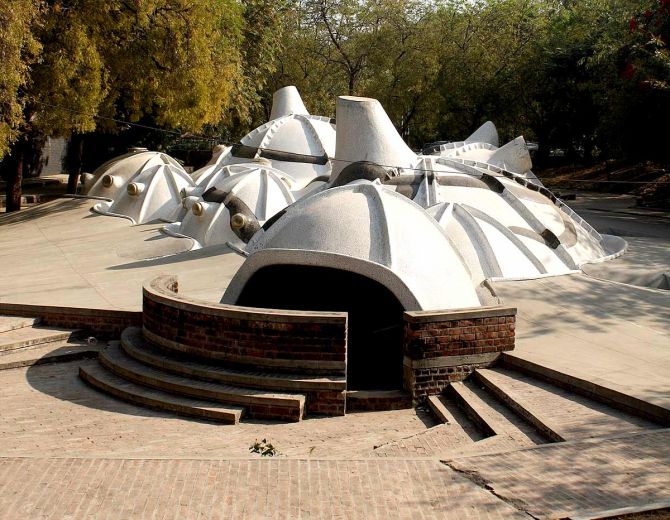Balkrishna V Doshi, who won the Pritzker Award in 2018 -- which is equivalent to the Nobel Prize in architecture -- passed into the ages this week.
Sohini Das recalls an encounter with the the legendary architect, who was posthumously awarded the Padma Vibhushan in this year's Republic Day honours list.

Balkrishna V Doshi's home, Kamala House (named after his wife), is nestled in a quiet, tree-lined lane in central Ahmedabad.
The entrance to it is so private that I twice mistake two other imposing structures nearby for Doshi's house only to be corrected by the neighbourhood watchman who eagerly guides me to the right one.
After a hectic Thursday, marked by interactions with the media, students and well-wishers, Doshi is relaxing in his living room that is awash with natural light.
A Husain is the only thing that stands out in this simple, functional space -- or perhaps it is the simplicity of the space that is striking.
Doshi's granddaughter, Khushnu Panthaki Hoof, also an architect and close associate at the Vastu Shilpa Foundation, his workplace, guides me to the backyard garden (a novel concept at the time this house was built in the 1950s).
It is here that Doshi chooses to sit and talk about his journey.
"It came as an absolute surprise, even say a pleasant shock," he says about the Pritzker award.
Doshi has been part of the Pritzker jury earlier and knows how the winner is chosen. The jury travels around the globe to study the creations of the architects it is considering for the award.

Doshi himself is an avid traveller.
"I used to travel for four months in a year, but have cut down a bit on that now," he says.
His favourite cuisine is Italian, besides chaat and the Indian thali.
As the aroma of a tangy curry travels from the kitchen, Doshi remembers how he survived eight months in France on cheese, olives and bread while working with Le Corbusier in his Paris atelier as an apprentice.
Much has been written about Le Corbusier's influence on Doshi's work.

Doshi, however, has evolved his own brand of sustainable development in which the building blends seamlessly with the surroundings and facilitates harmony between the built environment and its inhabitants.
He thinks of buildings as living organisms and believes in having a dialogue with them.
"My grandfather and his house (to which levels kept being added to accommodate the growing family) shaped my way of looking at things. And also the temple visits in Pune as a child," says Doshi, who designed the campus of the Indian Institute of Management Bangalore along the lines of the Madurai Meenakshi temple -- "complex, beautiful and workable".
The campus is one of his personal favourites, apart from the Amdavad ni Gufa (the underground art gallery).
Ask him what guided his choice of projects, and he says, "I like to see that the project is valuable in terms of its character. That character has to show timelessness."
He adds, "The client is an instrument to make it happen -- I give him his goods, but I must also enjoy the process. Say, if I own it, would I feel happy there?"
He explains philosophically, "We are born out of nature and we like to go back to nature -- not consciously, but instinctively, which we are now disconnecting from. The essence of architecture and planning is the quality of the space that you create."
Kamala House, too, is another favourite -- a space that he created and recreated over the decades. It was the first house in India that had cavity walls (to trap heat).
The project started when Doshi's father-in-law suggested that, given his temperamental nature, it would be wise if he built a house for his family to ensure a secure life.
There is still one project that Doshi wants to take up -- "reshaping" the Bhadra area in the walled city of Ahmedabad.
He wants to create spaces where street hawkers can be rehabilitated and organised so that they blend harmoniously with the surroundings.
"I want to create similar spaces across the city. I had made a plan for that, to link Bhadra with a bridge, connecting the eastern and western parts of the city," he says.
Doshi might be 90 but, as they say, a creative mind never ages.
This feature was published in Business Standard in 2018.
Feature Presentation: Ashish Narsale/Rediff.com












